Founders Environmental Impact
See how the story inspires YOU and ME to take action on the greatest challenge of all - what you can DO to sustain all of life.
International Living Future Institute
Published February 2021: https://living-future.org/lbc/case-studies/tanglewood
Tanglewood insights in hindsight
LBC PETAL CERTIFIED 2019
(Project start: 2013)
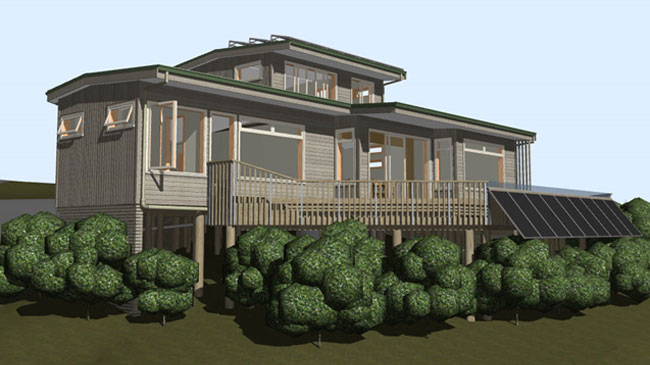
The project was a redevelopment of the site where the developer, Jon Brett, was born and raised. The original home was architecturally designed by his father and named Tanglewood in the late 1940s and continually extended through the 50s 60s and 70s. The original part of the house was eventually sold, and the remaining building dismantled. A new version of Tanglewood was designed to nestle in amongst native plants (instead of lawn and rose garden) re-using much of the salvaged timber and furniture from the old building.
Tanglewood has successfully achieved Petal Certification, focusing on Energy, Health & Happiness and Beauty. This Case Study focuses on insights in hindsight, hoping to show how EGO-centric projects can be ECO-centric, sensitive to both our own natural desires and the natural tendencies of the Place (eco is derived from the Greek oikos, meaning an extended family unit that consists of the house, members of the family and all property).
Whāia te iti kahurangi, ki te tuohu koe, me he maunga teitei.
Seek the treasures of your heart, if you bow your head, let it be to a lofty mountain.
A Whakatauki (proverb) from the Ancient Wisdom of the Maori.
We originally set our sights too low, too ego-centric. The Living Building Challenge encouraged us to be more eco-centric and consider a much loftier mountain in this new decade where, as Buckminster Fuller says: The future is a choice between Utopia and Oblivion.
Tanglewood is a regenerative project, returning a typical suburban property to a more natural state. We de-colonialised a typical English garden with neatly mown lawns and pretty rose gardens, replacing it with native bush which is naturally resilient without our intervention. The house was intended to step lightly on the land, with minimal earthworks, concrete, steel and construction waste.
Article Format
- Tanglewood’s Petal Goal.
- A quote conveying messages to link to readers’ current reality.
- Actions taken by the Bretts with links to the stories and templates behind the actions.
- Insights in Hindsight. For you to build upon so that we ALL address Bucky’s vision: ...to make the world work, for 100% of humanity, in the shortest possible time, through spontaneous cooperation, without ecological offense or the disadvantage of anyone.
Place Petal (in relation to connection to whenua-the land)
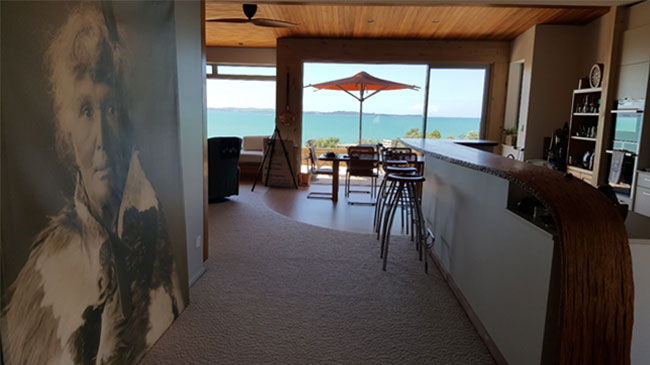
In Aboriginal worldviews, relationships are paramount in knowledge transmission. There can be no exchange or dialogue until the protocols of establishing relationships have taken place. Who are you? Where are you from? Where are you going? What is your true purpose here?…
From Sand Talk p169, by Tyson Yunkaporta, 2019
Goal: To demonstrate that building anything can be joyful and stress-less, while revealing sustainability lessons to facilitate healthy development for generations to come. (Achieved and on-going)
Actions:
- Took time to research the land: who, why, when indigenous and colonial aspirations, development and conflict impacted the site and environs. (See Unearth the facts about the land)
- Compromised, reframed, sacrificed in order to simplify development – specifically to prevent future conflict by eliminating cross-lease requirements.
- Learned and connected with the land through conversations with mana whenua (original people on the land)
- Worked with Te Whangai Trust, a social enterprise to decolonise our land and restore it with the diversity of native trees, bushes, birds and bees (sustainability of people & planet in action!).
Insights in Hindsight:
- There is high value in taking time to listen to the land and to those who came before. This builds connections and relationships.
- Consider one of the strategies we used. (See Journey into the Purple Circle)
- Highlight at least one action from each platform that you might undertake to connect with your site.
Energy Petal
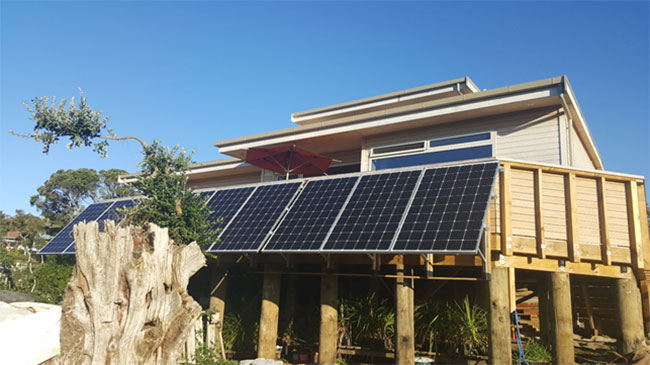
Fortunately, the Sun does not demand payment for all energy that it delivers by radiation to Earth in the overall cosmic scheme, which is trying to make humanity a success despite our overwhelming ignorance and fear…
… We may now care for each Earthian individual at a sustainable billionaire’s level of affluence while living exclusively on less than 1 percent of our planet’s daily energy income from our cosmically designed nuclear reactor, the Sun, optimally located 92 million safe miles away from us.
From Critical Path by Buckminster R. Fuller, 1981
Goal: To generate more renewable energy than actually needed, including energy for transport.
Actions:
- We calculated our annual energy budget based on our previous house built in 2000 with minimal insulation and all single glazed aluminium joinery. For Tanglewood, we added 5% for the Energy Petal requirement plus another 20% for an electric vehicle.
- Budget was Net 25%. Actual was Net 140% thanks to passive solar heating, massive insulation, an efficient heat pump and behavioural changes.
- A Tesla battery and 27 solar panels gave us 10kWh useable storage and about 50kWh/day generation on a cloudless summer day, and about half that in winter.
- Connection to the grid allowed for continuous power even if we had extended bad weather and ran the battery down.
Insights in Hindsight:
- Our car runs on sun!
- The cost of the solar generation and battery was less than the cost of constructing our driveway. NB: We don’t expect a $ return on investment from either nor should others.
- We advocate aiming for at least Net 100 to compensate for the embodied energy in the system, the house, the car. The time has come to always consider embodied energy!
- Let us not blame: Commonly, power companies are blamed for over-charging where in fact, they are only covering infrastructure costs whilst we pay only for what we consume.
- It is more inspiring to reduce our energy consumption now, because it contributes more to the grid for everyone to use. Reducing expenses is not nearly as much fun. (See From Footprint to Handprint)
Consider Jason McLennan’s (father of LBC) quote: The way to subvert the dominant paradigm is to have more fun than they do and make sure they know it
Health & Happiness
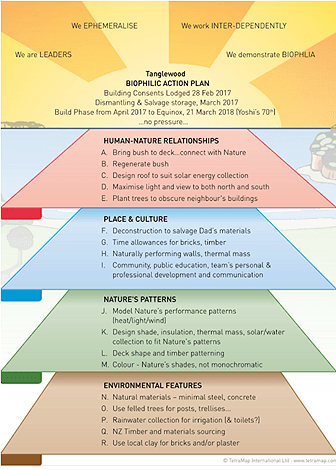 Biophilia means, the love of life…thus the love of Nature…thus the love of human Nature. It’s the last one…human nature that’ll make or break us. Nature will sustain just fine without us. The question is, What must we do NOW to care for and connect with the planet and each other to ensure an ecological, healthy, sustainable, biophilic future for all of life?
Biophilia means, the love of life…thus the love of Nature…thus the love of human Nature. It’s the last one…human nature that’ll make or break us. Nature will sustain just fine without us. The question is, What must we do NOW to care for and connect with the planet and each other to ensure an ecological, healthy, sustainable, biophilic future for all of life?
Yoshimi and Jon Brett, 2020
Goal: Tanglewood provides occupants and visitors, spaces and experiences designed to nurture optimum health and happiness. (Achieved and on-going)
Actions:
- Facilitated a biophilia workshop to connect neighbours, builders, consultants, designers with the site and our values. (See Inspire Biophilia with Creative Design Solutions)
- Introduced and worked through the meaning and demonstration of biophilia pre, during and post-build.
- Researched and implemented non-toxic strategies re: materials, fixtures, furnishings and cleaning to optimise health.
- Committed to behavioural shifts needed to minimise waste – e.g. efficient ventilation, insulation, waste reduction (principles: refuse-reduce-reuse-recycle)
Insights in Hindsight:
- Biophilia is far more than researched and proven principles that connect us with Nature.
- Biophilia is a love of life, thus love of Nature, thus love of human Nature. Human Nature and associated behaviours and beliefs have created beauty and clever technology…but more significantly, have created an over-populated planet drowning in its own waste.
- Biophilia – understanding and optimising our inter-dependent connections with Nature and with each other – must become MAINSTREAM.
- As biophilia becomes mainstream, we will see our handprints grow and footprints diminish.
Beauty
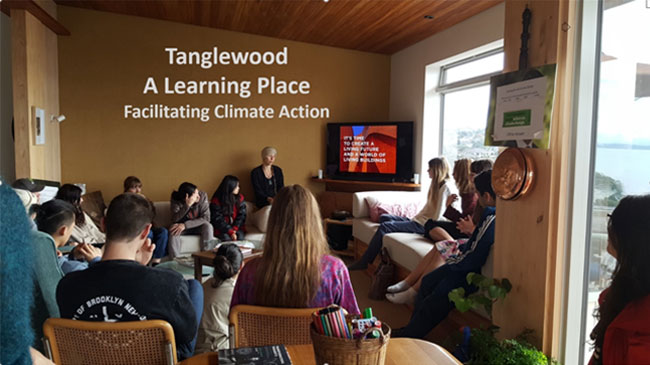
When I am working on a problem, I never think about beauty but when I have finished, if the solution is not beautiful, I know it is wrong.
Buckminster Fuller
Goal: Tanglewood is a manifestation of Nature’s beauty and spirit. (Achieved and on-going)
Actions:
- Design Phase: Contractors/Suppliers were given a brief that described our LBC project, defined our values and goals, and requested that they state their values as individuals and teams.
(see Collaborator Brief) - Salvaged timber and copper from Tanglewood 1, guava branches and clay soil from the garden were hand-crafted and positioned to connect inside to out.
- Tanglewood’s biophilic features provide a learning environment that relaxes, stimulates creativity and conversation.
- Tanglewood balances ego with eco, beauty with efficiency, advocacy with sanctuary.
Insights in Hindsight
- Create contexts that engage, welcome and arouse curiosity.
- Modelling is not enough… we must get everyone to be ‘hands-on’ and understand the consequences of looking away from our climate emergencies.
- We must be explicit, specific in advocating what TO DO.
- We must learn to work with and through conflict. COVID is Nature… how did we (especially in NZ) work through it? Consider always:
- How we lead…how we follow with and for Nature.
- Long-term consequences and impacts of our actions and thoughts on Nature and each other.
- How to work inter-dependently. Think: My success depends on your success.
- How to leverage diversity. Be: courageous, inclusive, kind, relentlessly positive.
In summary – take actions that result in:
- Reducing footprint AND increasing handprint.
- Eco over Ego.
- Biophilia as mainstream thinking and doing.
- Inter-dependent and diversity-respected solutions.
Read or re-read Transformational Thought by Jason McLennan. The chapter, Don’t Be a Tool, from page 77 is important. Given the choice, always seek to lower your environmental footprint even if it means a lower point score. J McLennan. mclennan-design.com
Buckminster Fuller (1895-1983) was wise, honest, searing, and courageous. He alerted us to the emergencies we are now experiencing. It’s late…but important to listen NOW:

We are called to be architects of the future, not its victims.

You never change things by fighting the existing reality
To change something, build a new model that makes the existing model obsolete.

Nature is a totally efficient, self-regenerating system. IF we discover the laws that govern this system and live synergistically within them, sustainability will follow and humankind will be a success.

There is no joy equal to that of being able to work for all humanity and doing what you’re doing well.
Symbols used with permission, copyright TetraMap International www.tetramap.com
The 2020s are the Design Science Decade. Learn why, what other great ecological thinkers and projects are achieving, and what you can DO to sustain all of life. www.bfi.org